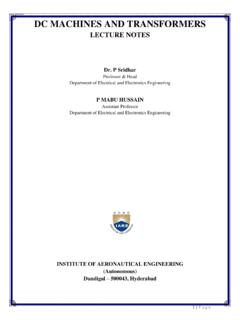Transcription of Tutorial for MEMS microphones - STMicroelectronics
1 February 2017 DocID025704 Rev 2 1/20 AN4426 Application note Tutorial for mems microphones Introduction This application note serves as a Tutorial for mems microphones , providing general characteristics of these devices, both acoustic and mechanical, as well as summarizing the portfolio available from ST. mems microphones target all audio applications where small size, high sound quality, reliability and affordability are key requirements. ST's mems microphones are designed, developed and manufactured within ST, creating an industry-unique, vertically integrated supply chain. Both analog and digital-input, top and bottom-port solutions are available. Our best-in-class AOP and SNR make ST s mems microphones suitable for applications that require a very high dynamic range, improving the audio experience in any environment.
2 Matching very tight sensitivity allows optimizing beamforming and noise cancelling algorithms for multi- microphone arrays. Low power consumption allows extending battery life. Contents AN4426 2/20 DocID025704 Rev 2 Contents 1 Mechanical specifications, construction details .. 4 2 Acoustic parameters .. 11 Sensitivity .. 11 Directionality .. 11 SNR .. 12 Dynamic range and acoustic overload point .. 12 Equivalent input noise .. 13 Frequency response .. 15 Total harmonic distortion .. 16 PSRR and PSR .. 16 3 mems microphone portfolio .. 17 4 Revision history .. 19 AN4426 List of figures DocID025704 Rev 2 3/20 List of figures Figure 1: mems microphone inside package .. 4 Figure 2: mems transducer mechanical specifications.
3 4 Figure 3: Capacitance change principle .. 5 Figure 4: 4 x 5 package .. 5 Figure 5: 3 x 4 metal cap package - bottom port .. 6 Figure 6: 3 x 4 package - top port .. 6 Figure 7: 2 x 3 package - bottom port .. 7 Figure 8: Faraday cage in ST s mems microphones .. 7 Figure 9: RF immunity simulation .. 8 Figure 10: EMC test setup .. 8 Figure 11: RF test disturbance signal with sinusoidal pattern .. 9 Figure 12: RF immunity test results - MP34DT04 .. 9 Figure 13: RF test disturbance signal @ 217 Hz burst pattern .. 10 Figure 14: RF immunity of analog differential microphones .. 10 Figure 15: Omnidirectional microphone .. 11 Figure 16: A-weighted filter response .. 12 Figure 17: Acoustic and electrical relationship - analog .. 13 Figure 18: Acoustic and electrical relationship - digital.
4 14 Figure 19: MP45DT02-M frequency response .. 15 Figure 20: mems microphone portfolio .. 17 Figure 21: mems microphone notation .. 17 Mechanical specifications, construction details AN4426 4/20 DocID025704 Rev 2 1 Mechanical specifications, construction details A microphone is a dual-die device consisting of two components, the integrated circuit and the sensor, which are housed in a package using techniques that are proprietary to ST. Figure 1: mems microphone inside package The sensor uses mems technology (Micro-Electrical-Mechanical Systems) and it is basically a silicon capacitor. The capacitor consists of two silicon plates/surfaces. One plate is fixed while the other one is movable (respectively, the green plate and the grey one shown in the following figure).
5 The fixed surface is covered by an electrode to make it conductive and is full of acoustic holes which allow sound to pass through. The movable plate is able to move since it is bonded at only one side of its structure. A ventilation hole, allows the air compressed in the back chamber to flow out and consequently allows the membrane to move back. The chamber allows the membrane to move inside but also, in combination with the chamber created by the package will affect the acoustic performance of the microphones in terms of frequency response and SNR. Figure 2: mems transducer mechanical specifications So basically the microphone mems sensor is a variable capacitor where the transduction principle is the coupled capacitance change between a fixed plate (back plate) and a movable plate (membrane) caused by the incoming wave of the sound.
6 mems sensorASIC (Applicationspecificintegratedcircuit)AN 4426 Mechanical specifications, construction details DocID025704 Rev 2 5/20 Figure 3: Capacitance change principle The integrated circuit converts the change of the polarized mems capacitance into a digital (PDM modulated) or analog output according to the microphone type. Finally the mems microphone is housed in a package with the sound inlet placed in the top or in the bottom part of the package, hence the top-port or bottom-port nomenclature of the package. ST manufactures microphones using industry-wide techniques, but also has developed innovative packaging to achieve improved performance of the microphones . Packaging techniques will be discussed in further detail. The 4x5 package is widely used to house the digital microphone MP45DT02-M.
7 It is a common packaging technique in a top-port configuration where the ASIC is placed under the sound inlet with glue on top (glob top) in order to protect the circuit from light and the mems sensor is placed beside the integrated circuit. The two silicon components are fixed to the substrate and the pads of the device are on the bottom side. The resonant chambers are identified depending on the position of each chamber with respect to the membrane and the incoming sound. In this case, considering the incoming direction of the sound, the front chamber is created by the package and the chamber inside the mems , behind the mems membrane, is the back chamber. This configuration allows protecting the mems from dust and particles falling into the package but results in a low SNR and frequency response with a peak in the audio band.
8 Figure 4: 4 x 5 package The 3x4 package is used in ST to produce both the bottom and the top-port digital microphones , MP34DB02 and MP34DT01-M, MP34DT04/-C1, and MP34DT05. Considering the bottom configuration first, this structure is depicted in the following figure. The ASIC and the mems sensor are fixed to the substrate and the pads of the device are on bottom side as well. The sound inlet is obtained by drilling the substrate according to the position of the mems sensor. The package encloses all the components. In this configuration the front chamber is the cavity of the mems sensor and the package creates the back chamber. This design optimizes the acoustic performance of the microphone in terms of SNR and also allows obtaining a flat response across the entire audio band.
9 The drawback of this solution is represented by the assembly of this microphone . Usually the Mechanical specifications, construction details AN4426 6/20 DocID025704 Rev 2 bottom-port microphones are soldered on the PCB. The thickness of the board modifies the volume of the front chamber, degrading the flat response of this type of microphone (refer to AN4427, Gasket design for optimal acoustic performance in mems microphones for details). In order to minimize the artifacts caused by this environment, a flex cable is recommended to be used. Additionally, the bottom-port microphones have a ringed metal pad around the hole. A very careful soldering process is required to avoid dust or soldering paste from entering in the sound port, damaging the mems membrane.
10 Figure 5: 3 x 4 metal cap package - bottom port The 3x4 top-port configuration is basically a mirrored bottom-port microphone . The ASIC and the sensor are placed close to each other, the sensor is still under the sound inlet but these two components are attached to the top of the structure, in other words, the ASIC and mems are fixed to the package lid, not to the substrate. The pads are on the substrate and thus on the bottom side of the microphone . This configuration, covered by ST patents, allows optimizing all the benefits of the bottom-port microphone in terms of acoustic performance ( maximized SNR and flat band) and all the benefits related to the top-port configuration during the assembly process. Figure 6: 3 x 4 package - top port AN4426 Mechanical specifications, construction details DocID025704 Rev 2 7/20 A smaller package, x mm, has been introduced in ST's product portfolio (for simplicity referred to as 2x3, see Figure 7: "2 x 3 package - bottom port").












